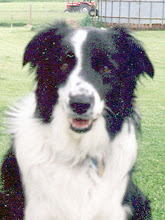
More than one person has called her socially-backwards.
We just call her an odd duck.
We suspect that Caeli, our Border collie, wasn't socialized as a young dog. She was rescued from a shelter when she was a young adult.
When she arrived at our house, it was clear she didn't know how to act around dogs, cats and people.
She wanted to play with cats, but they wanted nothing to do with her wiggling, pawing and nose poking. She'd sidle up to me for attention. Again, she wiggled and pawed and was unsure how to act. She postured and growled when other dogs approached, and then, they kicked her butt.
New places stressed her. Car rides stressed her. A person watching her drink water stressed her.
The one thing that didn't stress her were sheep.
With sheep, that herding instinct overtook her fears and worries.
Caeli went to her first herding trial over the weekend. We didn't know how she'd react. Some dogs shut down when at a new place and with new sheep. Some become overzealous, chasing the sheep and ignoring their handlers.
Caeli wasn't fond of the new dogs and the new place. The hotel room and traffic stressed her. But on the trial field, she was quite at home. She worked, and listened, and was quite happy.
That instinct, bred into her generation after generation, won out.










































